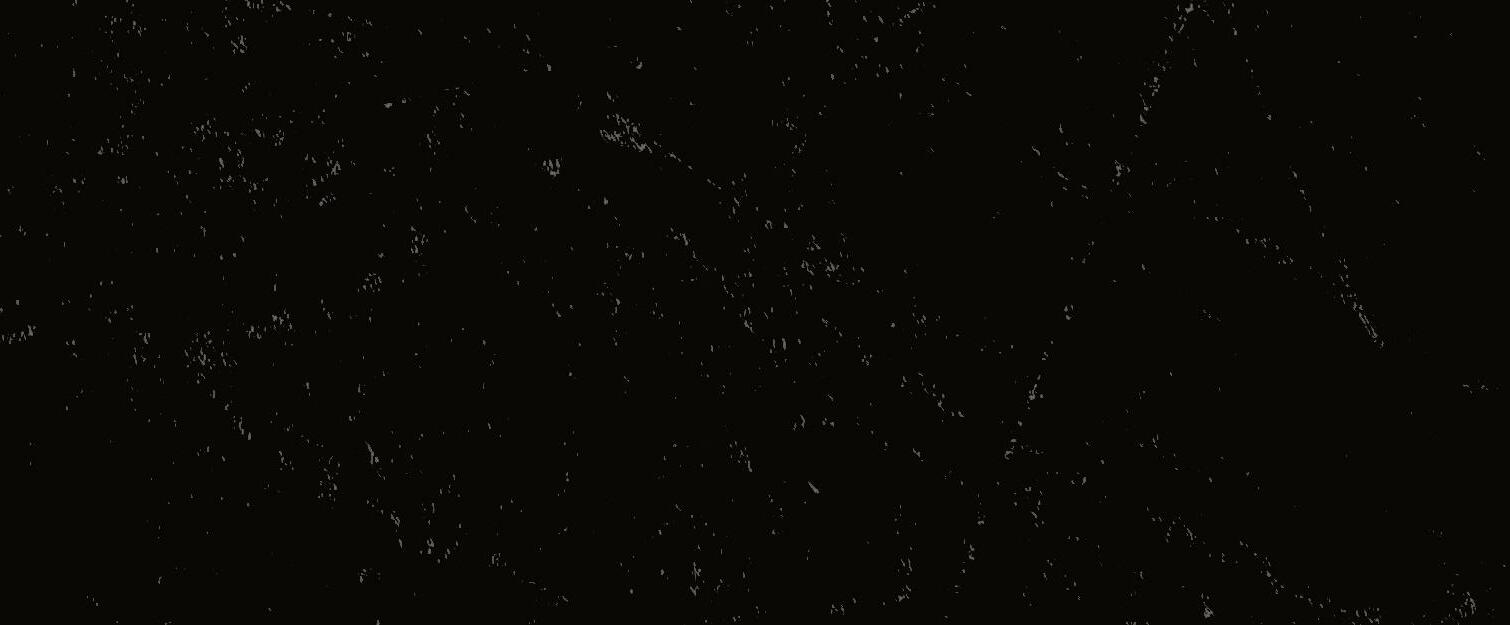Truth to justice
Holocaust survivor talks to Arizona court
Welcome to town
The Schulmans already baked challah here Gorbachev’s autograph
A powerful moment with the late Soviet leader
the beginning
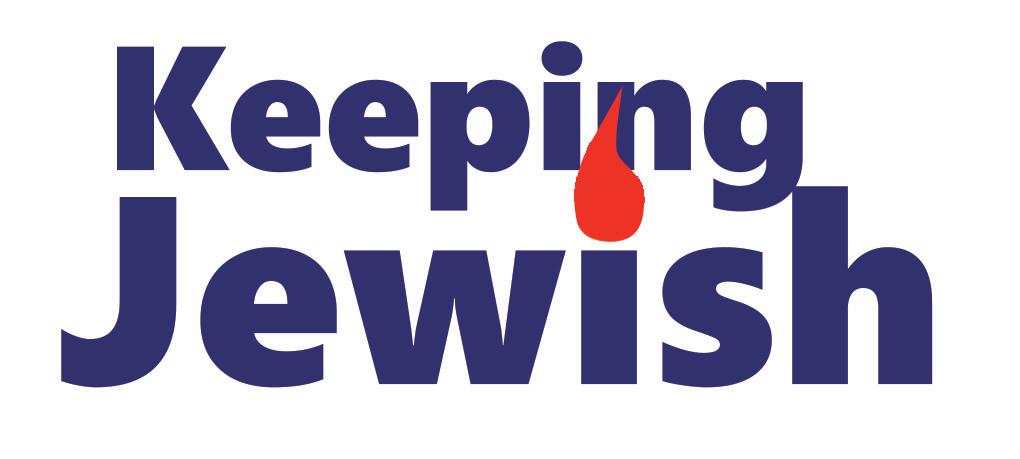

Holocaust survivor talks to Arizona court
The Schulmans already baked challah here Gorbachev’s autograph
A powerful moment with the late Soviet leader

The odd timing of the Sukkot holiday, why it rains, and how to celebrate it
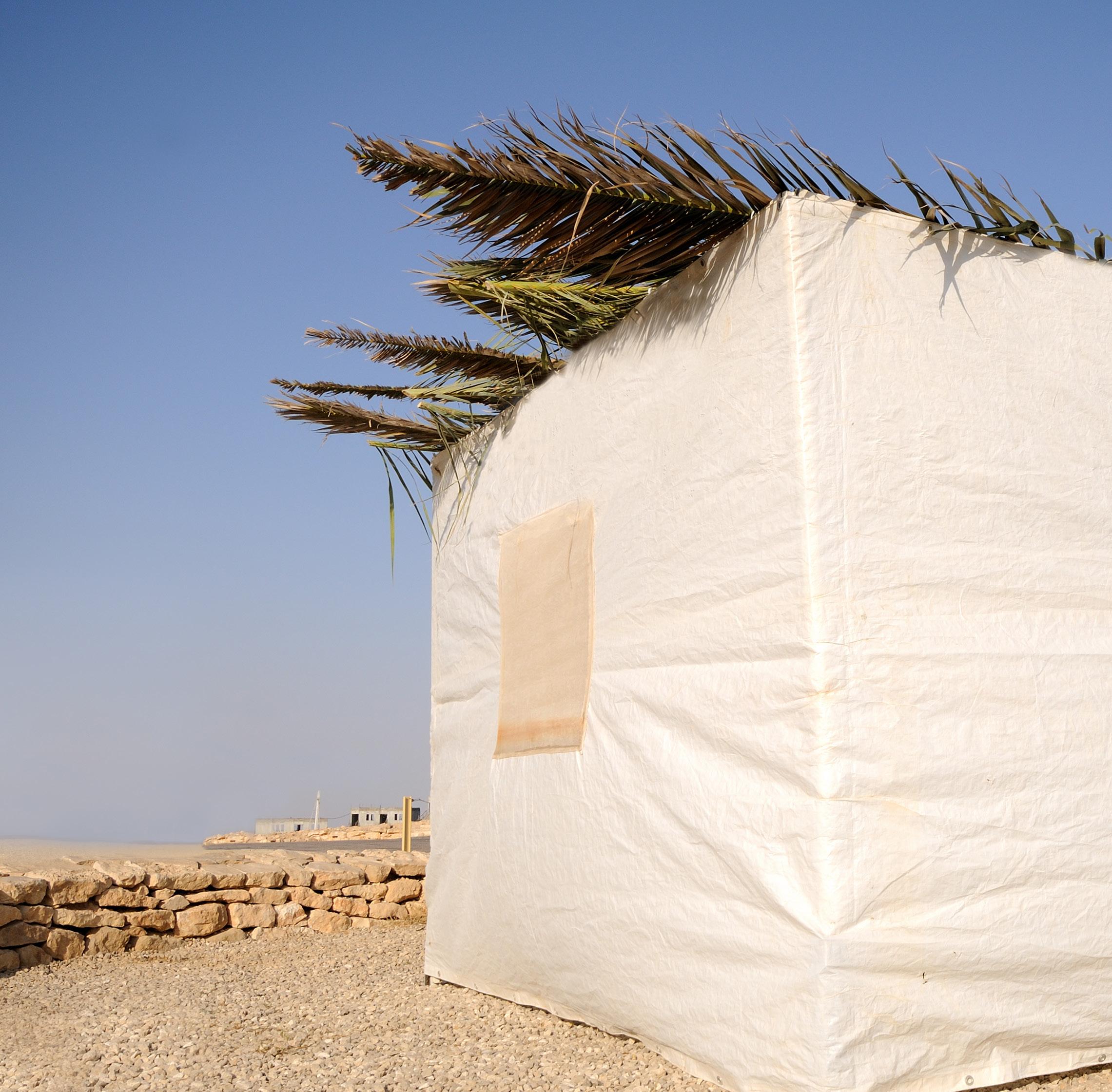
The Jewish outreach and education network of Southern Arizona 2443 E 4th Street, Tucson, AZ 85719

EXECUTIVE DIRECTOR
Rabbi Yossie Shemtov
Chanie Shemtov
Rabbi Yehuda Ceitlin
Feigie Ceitlin
Affiliates: Congregation Young Israel, Chabad at the University of Arizona, Chabad on River, Chabad of Oro Valley, Chabad of Sierra Vista, Chabad of Vail and Lamplighter Chabad Day School of Tucson
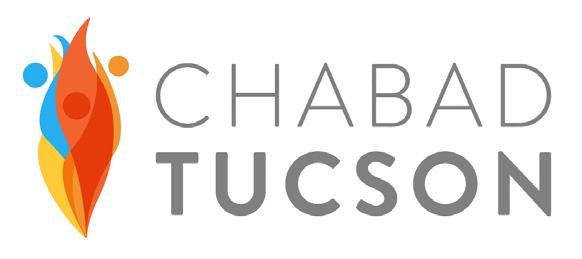
Rabbi Yehuda Ceitlin
Suzanne Cummins
Feigie Ceitlin, Shannon Levitt, Cynthia Meyers, Menachem Posner, Mordechai Schmutter, Sofya Sara Esther Tamarkin, Benjamin Weiss
PHOTOS
Amite (cover photo)
SPECIAL THANKS Chabad.org
EDITORIAL INQUIRIES OR ADVERTISING
Phone: 520-955-9680
Email: info@ChabadTucson
Keeping Jewish is published in print periodically by Chabad Tucson and is distributed free in Tucson and around Southern Arizona
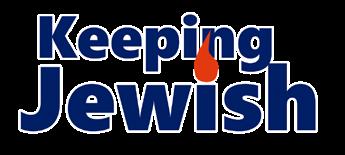
Chabad Tucson does not endorse the people, establishments, products or services reported about or advertised in Keeping Jewish unless specifically noted. The acceptance of adverti sing in Keeping Jewish does not constitute a recommendation, approval, or other representation of the quality of products or services, or the credibility of any claims made by advertisers, including, but not limited to, the kashrus of advertised food products. The use of any products or services advertised in Keeping Jewish is solely at the user’s risk and Chabad Tucson accepts no responsibility or liability in connection therewith.
Note: “G-d” and “L-rd” are written with a hyphen instead of an “o .”This is one way we accord reverence to the sacred divine name. This also reminds us that, even as we seek G-d, He transcends any human effort to describe His reality.
The holiday of Sukkot was somewhat in tense during my childhood. Though Octo ber brings to mind cozy sweaters, hot apple cider, and falling leaves for much of North America: in my hometown of Montreal, it was typically already bitterly cold that time of the year.
Sukkot, which begins on the evening of Oc tober 9, commemorates the shelter which G-d gave the Jewish people during their journey to the Holy Land after their Exodus from Egyptian slavery. For seven days and nights, we eat our meals in the sukkah and regard it as our home. Whatever could be done should be done in the sukkah.
OPINIONWe used winter coats and portable heaters to keep us warm in the sukkah. We had sho vels handy to sweep the snow off the s’chach — the sukkah’s fragile roof made of unpro cessed natural vegetation—often bamboo, pine boughs, or palm fronds.
As a child, as I desperately tried to finish my matzo ball soup before it became cold from the low temperatures or the pouring rain, I often pondered why Sukkot is celebrated at such an inconvenient time. Springtime and summertime are nice enough in Cana da; couldn’t we sit outside for a week then instead?
What is more, my birthday is on Sukkot. You can imagine how well a sukkah in Mon treal serves as a party venue. With low-han ging lights, balloons were a hazard. Party guests would need to squeeze together on
wooden benches and eat the birthday cake with thick mittens.
Historically, Sukkot has little in common with the numbing cold that my family and I endured each October. The Jews left Egypt in the springtime, and there was no snow in sight as they traveled through the Sinai Desert protected by G-d. October weather there ranges from a high of about 89 by day to lows in the mid-70s at night.
In truth, the inconvenience of Sukkot is not a bug: it’s a feature. In fact, if a sukkah is too comfortable, it runs the risk of not being kosher. The roof must be made of flimsy, un processed branches — add some adhesive or a tarp, and it’s not a sukkah anymore.
It reminds us that our comfortable lives can be turned upside down in an instant, as the state of the world today vividly demonstra tes. The medieval Rabbi Jacob Ben Asher (The Tur) explained that Sukkot emphasi zes how the Jews rely on G-d for protection. So if it took place in the spring, when we can all be comfortable outside, we’d miss the point.
That rain dripping onto the soup, the snow in my native Canada — or the hot Arizona sun beating down on my chocolate birthday cake — are reminders of the frailty of our existence, of how much we all rely upon G-d to keep us safe and sheltered.
On Sukkot, instead of complaining about the weather, I have learned to embrace it — the discomfort is a reminder of why we’re thankful for the comfort we enjoy the rest of the year.
- Rabbi Yehuda Ceitlin is the Outreach Director of Chabad Tucson
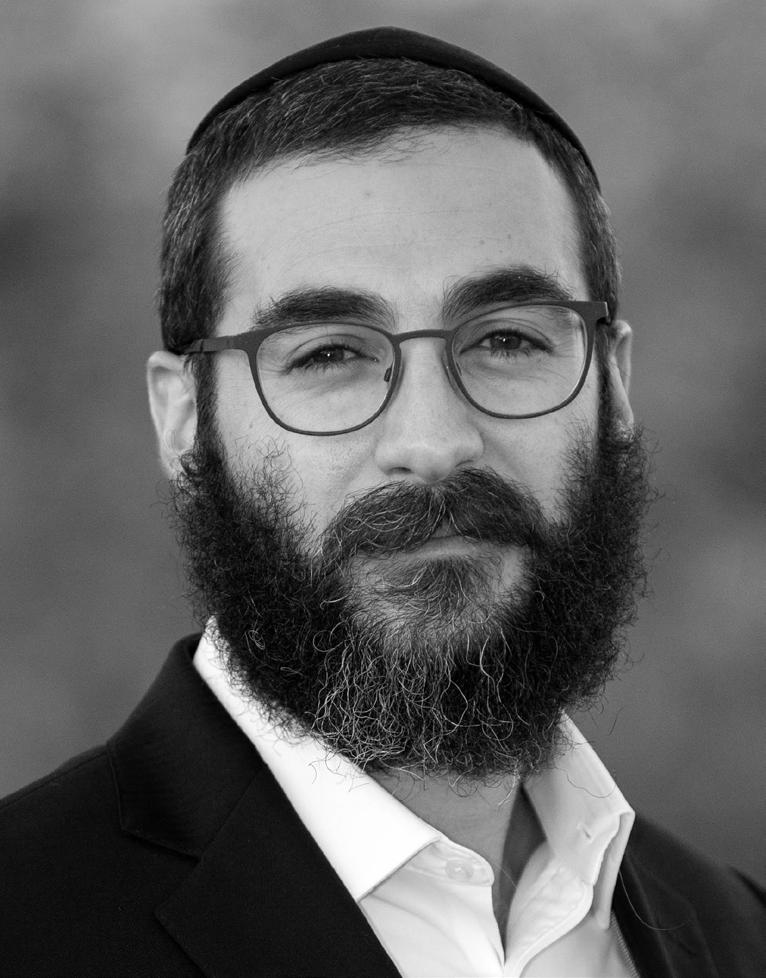
School children in Cochise County, Arizona are learning about the joy of giving charity with a Chabad program inspired by Jewish teachings and the biblical story of Noah.
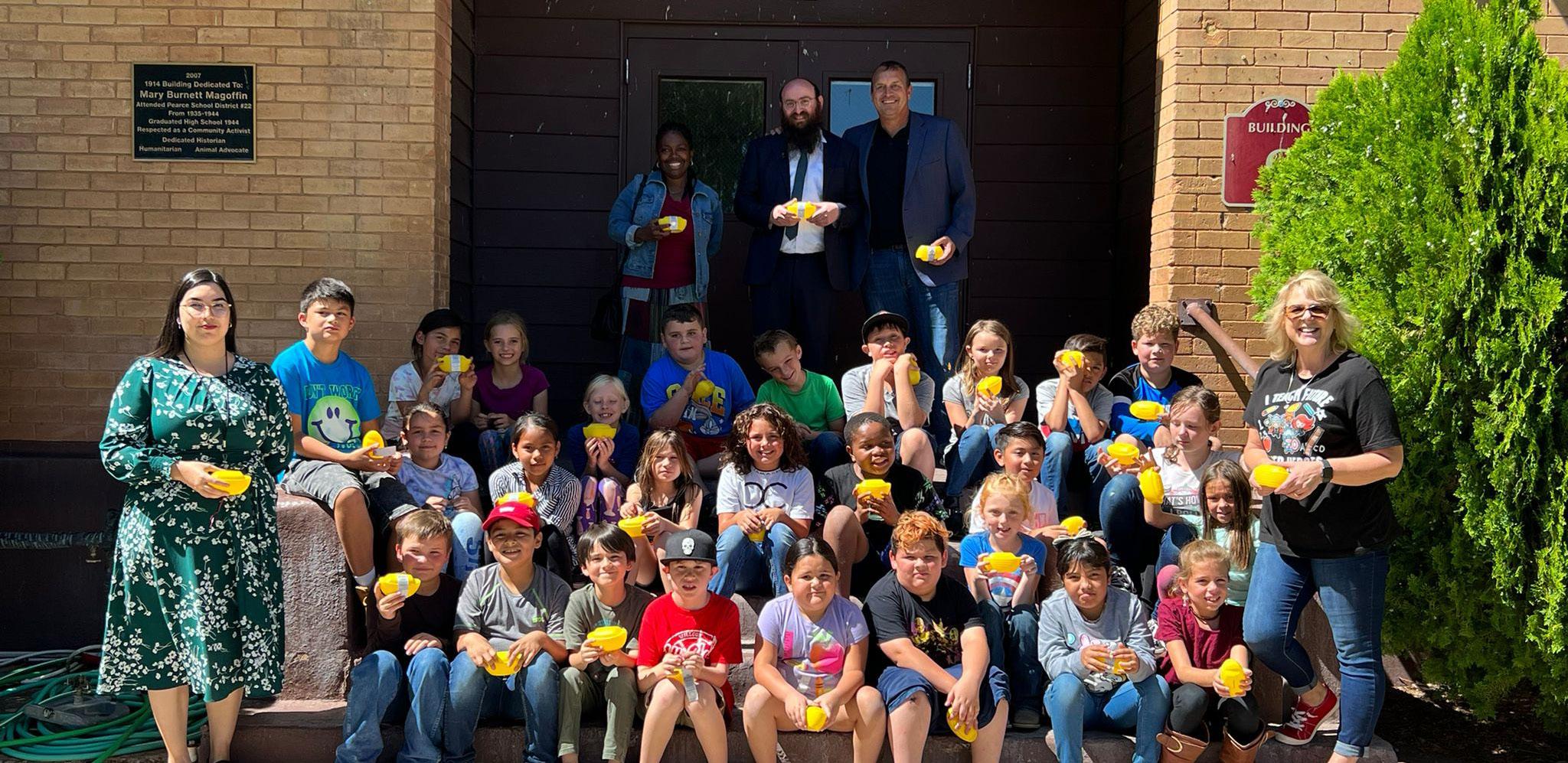
The ARK Project, which stands for Acts of Random Kindness, provides a bright yellow tzedakah (charity) box shaped like an ark to participating schools. People of all ages and faiths are encouraged to place coins in side the ark (box) regularly. Once the box is filled, the money is emptied and given to others less fortunate.
The box was inspired by the ark Noah built when humankind descended into a state of anarchy and lawlessness and G-d sent the Great Flood (2704-1754 BCE) as a conse quence. Right now, the world seems filled with conflict, misery and malice. The slogan
of the ARK project is “Let’s get hope floating again.”
Originating in South Africa, the initiative was introduced to Cochise County by Sierra Vista-based Chabad Rabbi Benzion She mtov. “I wanted to partner with the schools, helping to generate positivity in our com munities through kindness and compas sion,” he said.
To School Superintendent Jacqui Clay, the ARK project “seemed like a natural progres sion” as Cochise County Schools are parti cipating in The Be Kind People Project, a youth development program that focuses on creating a Culture of Kindness at the schools.
“The ARK Project empowers children to
feel like they can make a difference in the world.” Clay said. She said the ark-shaped box becomes a visual reminder of the impor tance of giving, and the daily act of placing coins in the box allows students to demons trate their compassion.
Each school or class will select an organiza tion to be the recipient of the accumulated contributions and the students will donate the money to the chosen organization at the end of the year.
The School Superintendent’s Office kicked off the project on September 15th at the Pearce Elementary School, with the support of Superintendent and Principal Kyle Hart. Teacher Maria Ferrel’s Fourth Grade class and Teacher Amber Landwerlen’s Third Grade class were given a presentation by
Rabbi Shemtov, together with the ark-sha ped boxes.
The Pearce Elementary students can earn pennies from the teachers by performing acts of kindness or by sharing a fellow classmate’s random act of kindness with the class. Teachers note that some of the chil dren have begun to bring coins from home as well, as the daily routine of giving has become more established. They also note that there has been an increased discussion among the children about how to help the community with the money.
“With the help of these arks, we are shifting our mindset from acts of selfishness to being more selfless and helping others,” Rabbi Shemtov said.
Running, tripping over dead bodies, and an overwhelming sense of fear are the things that Marion Weinzweig remembers most from her childhood in Poland. She was one of only a few members of her family to sur vive the Holocaust.
She recounted those painful memories and her story of survival to about 200 people at the Arizona Supreme Court on Thursday, Sept. 22, in “Living Through the Holocaust,” a talk sponsored by the Jewish Lawyers’ As sociation (JLA) and hosted by the Arizona Court of Appeals.

David D. Weinzweig, Marion’s son and the only Jewish judge on the Arizona Court of Appeals, proudly introduced his mother, ca lling her “a true survivor imbued with cou rage and grace, grit and gumption, virtue and intellect.”
“All I am is from her,” he said. A majority of Arizona Supreme Court and Court of Appeal justices were in attendance, along with lawyers, law students and com munity members.
Marion, a slight and elegant woman, opened her talk by impressing upon her audience the importance of learning Holocaust his tory and the dangers of antisemitism. She spoke of the rise in antisemitic incidents in the country and the prevalence of Jewish victims in religiously motivated hate cri mes.
“The plague of antisemitism is more conta gious today than at any time since the Ho locaust, where 90% of Poland’s three million Jews were murdered,” she said.
Her voice was soft but steady, and though
she had to stop several times to sip water during her hour-long talk — saying she was nervous because she is not a professional speaker. But she never wavered in the cla rity of her tale.
She did tear up one time, however. That mo ment came when she spoke of her family’s decision to hide her with a Catholic family, the Ropelewskas, in her hometown of Opa tów, Poland, early in 1942.
“My aunt told me that my mother was crazy about me,” she recounted. Before letting her little girl go, she said, “my mother just kept hugging and kissing me and holding me.
“My father took me up to the carriage and my mother stood back crying,” she said. “That was the last time I saw her and that was the beginning of the darkest period of my life.”
Marion described how her father and his si blings found a way out of the ghetto to find work, ending up as slave laborers at an am munition factory in Starachowice, a nearby town. Her mother, who had stayed behind with her father’s parents, was in the Opa tów ghetto on Oct. 20, 1942, when it was li quidated. Those who weren’t killed at once were sent to the Treblinka death camp.
Marion’s mother was 25 when the Nazis murdered her. No one on that side of her fa mily survived.
“I really was supposed to be in Treblinka with them, but I am with you here today through the unselfishness of my parents who gave me away,” Marion said.
However, she explained, she didn’t remain long with the Ropelewskas. The neighbors
Marion Weinzweig at her presentation at the Arizona Supreme Court on Thursday, Sept. 22, 2022 * Photo: Shannon Levitt/JewishAZ.comwere suspicious of her presence and the Na zis investigated the family. They became too scared to keep her and sent her off with a driver. A little girl, she was left by the side of a road near a convent. Nuns took her in and baptized her.
Then the convent was destroyed by errant bombs and Marion ran away. So began a very harrowing period of time she chose not to share in detail. Eventually, she en ded up at another convent before the war ended. After much difficulty and expense, her father was able to find and retrieve her.
Once they were reunited with her father’s siblings, they lived together as displaced persons until 1948, when they emigrated to Canada. Even there Marion had a difficult life, moving from her father’s home to fos ter care and finally moving in with her aunt and uncle.
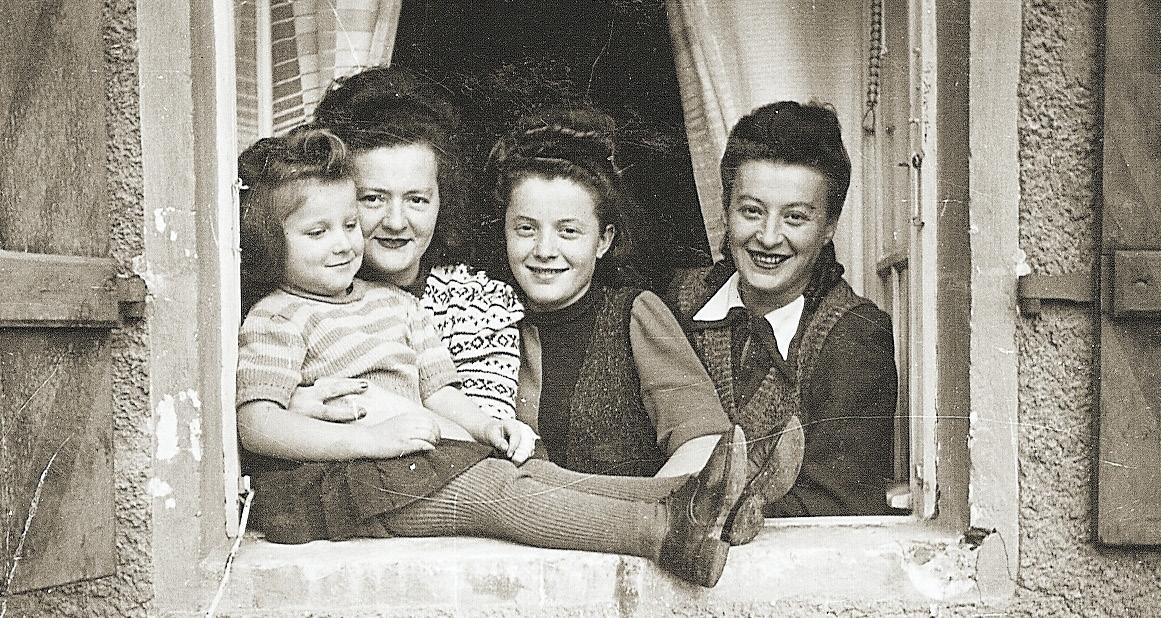
She said that growing up around survivors was difficult. The adults all told her how lucky she was that she was a child and sur vived. But she felt angry and confused and received no help for her emotional pain.
“I was a tortured soul going day by day,” she said. “Only now, in my old age, am I starting to deal with it.”
Marion was only 4 years old when the war ended, but she spent years piecing together what had happened to her and her family. Some of the details came from her own me mory, some from what her few surviving fa mily members told her, and the rest came from the help of a private investigator she hired as an adult. She was determined to recover what she could from her childhood.
The investigator found letters and docu ments from her parents, and Marion was able to talk to, and even meet in person, some of the people who had played a large role in her first years. She was able to speak with the driver who left her at the convent and some of the nuns.
She was relentless in discovering a past that she could share with her children. “I wanted to give them my life so they would know things that I didn’t know,” she said.
After years of trying to find out every piece
of information that still existed, she hired a Polish assistant and took her children with her as she “stormed city hall,” she said. She finally saw her own birth certificate. “At the age of 70, I found out that my real birthday was actually eight months earlier than my father told me.”
Marion’s talk weaved her personal his tory with the larger historical context of Germany’s invasion of Poland, the situation of Jews on the ground and the Holocaust. She said she wanted to give people enough examples that they could understand visce rally what that world had been like.
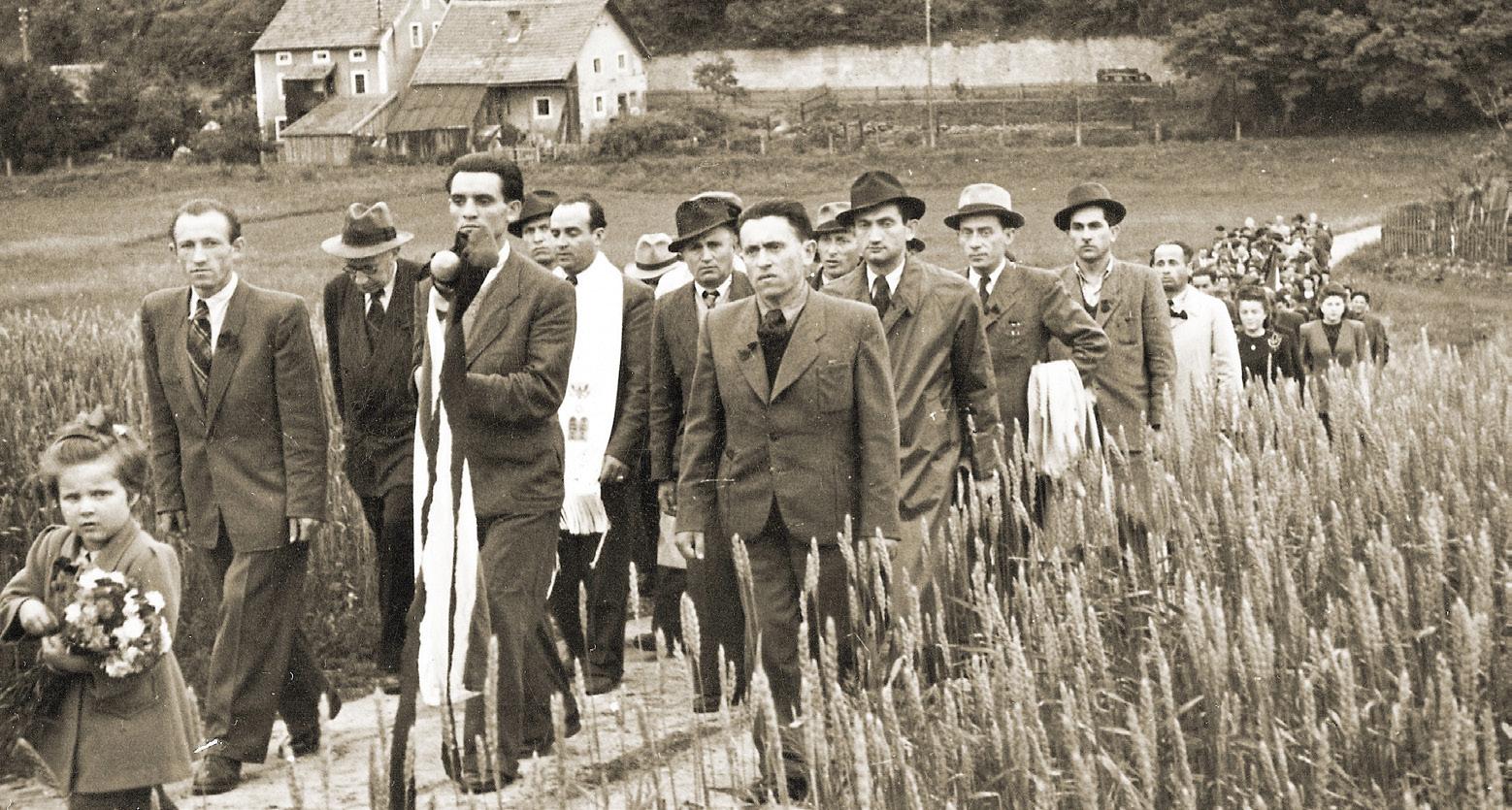
She mentioned the Wannsee Conferen ce, where the Final Solution was decided. Knowing her listeners were made up mostly of lawyers, she pointed out that a majori ty of the participants at Wannsee had also been lawyers.
Looking out at her audience, she took a beat and said, “Interesting.”
She ended her talk by exhorting her liste ners to be vigilant and “to speak up when we see signs of hatred and discrimination — and that’s both from the left and the right because antisemitism does not have a par ty.”
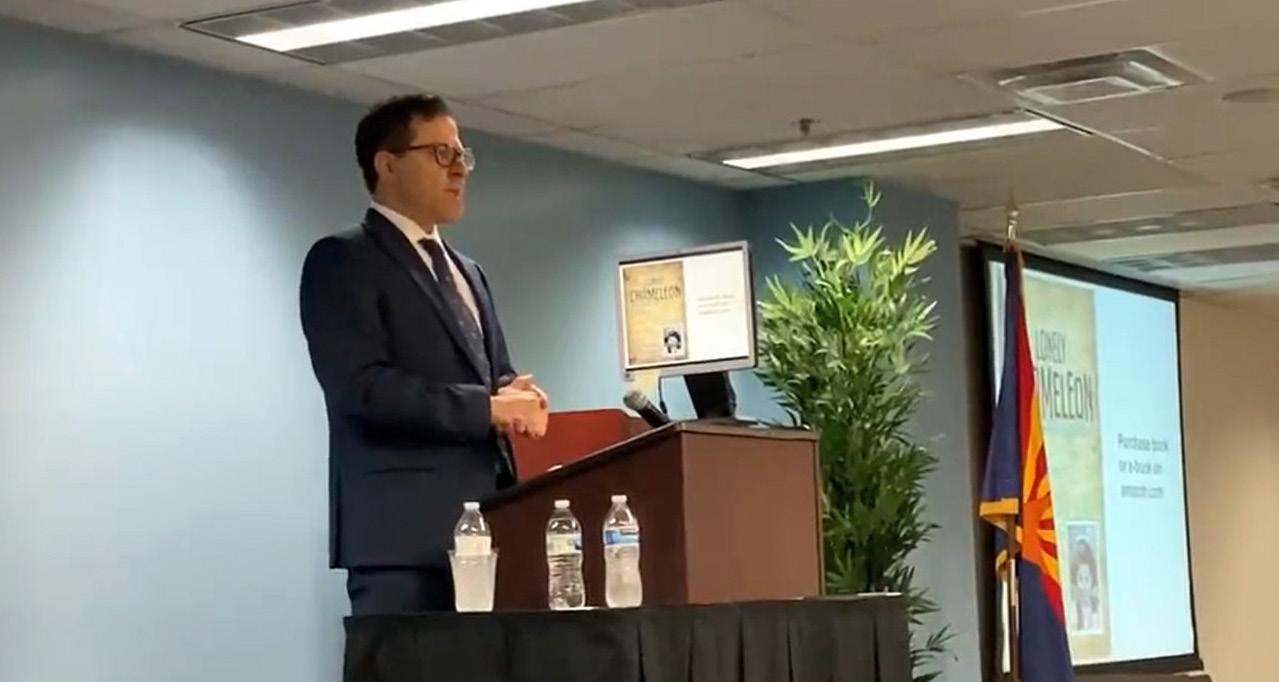
Vanessa Kubota, who was instrumental in organizing the event, said she was inspi red to see so many venerable justices there.
“It shows their dedication to ensuring that the truth of this heinous event be told,” she said.
Marion shares her story with many people these days and has written a book, “Lonely Chameleon: Memoir of a Child Holocaust Survivor.” But the first time she told her story publicly was when she was visiting Dachau with her daughter. The two listened in as the English-speaking tour guide told a group of tourists that none of the children survived; her daughter pushed her to speak out.
Marion raised her hand and said, “I’m alive,” and spoke to the group extempora neously.
“I came out of the closet then,” she said. “I’m telling you who I am.”
(From left) Mania Sztajman in the hands of Toby Frimmerman Sztajman Nacha Kleinberg, and Chava Frimmerman in the Jewish DP camp in Woerth an der Donau, Germany in 1948 Mania Sztajman leads a procession of DPs to a memorial in a cemetery near Woerth an der Donau, Germany in 1947 Arizona Court of Appeals judge David Weinzweig introduces his mother, Marion WeinzweigYom Kippur, which means “Day of Atone ment,” is the holiest day of the year, when we are closest to G‑d and to the essence of our souls. In 2022, it begins at 5:47 PM on Tuesday, October 4, until 6:40 PM on Wed nesday, October 5 (these times are for the Tucson area).
For nearly 26 hours we “afflict our souls” by avoiding the following: Eating or drin king (in case of need, see here and consult a medical professional and a rabbi), wearing leather shoes, washing or bathing, applying lotions or creams, engaging in marital rela tions. Like Shabbat, no work is to be done.
Before sunset, women and girls light holi day candles. The color white is traditionally worn as this is the day we are likened to an gels. Some married men wear a simple, long white garment called a kittel. The kittel is also the traditional Jewish shroud; wearing it reminds us of our mortality and urges us to repent.
Kol NidreOn Yom Kippur, the tallit (prayer shawl) is worn for all the prayer services. For Kol Ni dre, the Torah scrolls are all removed from the Ark and the procession of scrolls moves towards the bimah (reading table) while everyone kisses and embraces the passing
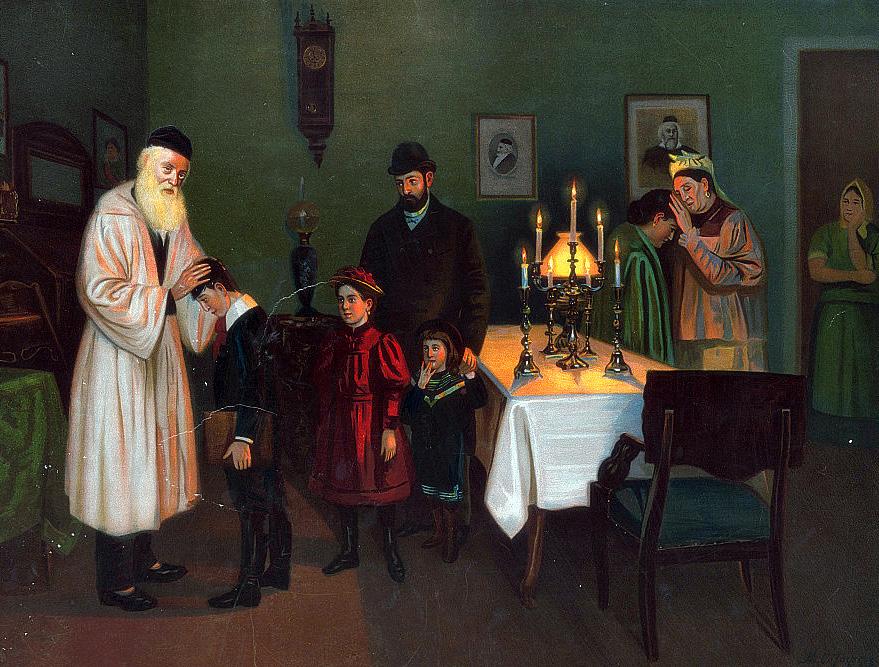
Torahs.
After requesting permission, from both the heavenly and earthly courts, to “pray with the transgressors,” the cantor begins the Kol Nidre. Kol Nidre is chanted three times, each time on a slightly higher note. The con gregation reads along with the cantor, in an undertone.
The Kol Nidre is followed by a few brief verses and prayers and culminates with the Shehecheyanu blessing, in which we thank G‑d for “granting us life, sustaining us, and allowing us to reach this occasion.” This blessing is recited in honor of every holiday, but usually following the night’s kiddush. On Yom Kippur, because there is no kiddush, the blessing was incorporated as part of the prayers. (Women and girls do not recite this blessing with the congrega tion—as they have already recited it after lighting the holiday candles).
In most congregations, at this point, the rabbi delivers a sermon. In many congre gations, this sermon is accompanied by an appeal—for charity has the power to evoke heavenly mercy.

The evening prayer service then commences.
During Yom Kippur, every time we say the second verse of the Shema, the “Baruch Shem” verse—“Blessed is the Name of the glory of Your kingship forever and ever”—it is proclaimed out loud. Throughout the year, this blessing is recited in an undertone, as it was “borrowed” from the angels. On Yom Kippur, however, we are likened to angels, so we too, like the angels, can recite it out loud.
The special Yom Kippur Amidah (standing prayer) incorporates a lengthy confession of sins. This confession is recited silently, and with each sin that we confess, we lightly knock our chest—the domicile of the heart, the seat of our passions and impulses—with our fist. The confession is later repeated, after the Amidah, together with the entire congregation. This double confession is re peated during all the day’s prayers, with the exception of the final Ne’ilah prayer.
The Amidah is followed by liturgy intersper sed with the recitation of the verses (Exodus 34:6–7) that allude to G‑d’s Thirteen Attri butes of Compassion: “G‑d, G‑d, benevolent
G‑d, compassionate and gracious, slow to anger and abounding in kindness and truth; He preserves kindness for two thousand ge nerations, forgiving iniquity, transgression and sin, and He cleanses.”
The entire Kol Nidrei and evening service should take approximately two hours. Many have the custom to recite the Book of Psalms after the evening service.
Yom Kippur Morning and Early After noon
The joint morning and Musaf services oc cupy the bulk of the day (approximately six hours). The morning service follows the or der of the traditional Shabbat and holiday service. The special Yom Kippur Amidah and confession are recited, followed again by songs and Yom Kippur liturgy.
Two Torah scrolls are taken from the Ark, in which we read about the Yom Kippur service in the Holy Temple in Jerusalem. The hafto rah discusses the concepts of repentance and fasting, the themes du jour of Yom Kippur.
In many communities, the aliyahs—who se supply doesn’t meet the demand, due to the large crowd and the auspiciousness of the day—are auctioned off to the highest bidders, with the monies raised earmarked for a charitable cause.
This is followed by the Yizkor service—tra ditionally preceded by the rabbi’s homily. In the Yizkor prayer, we beseech G‑d to kindly remember the souls of our dear departed ones; those whose parents are both still ali ve traditionally leave the sanctuary for the duration of this prayer.
In the Musaf service, the most prominent feature of this is the Avodah, a lengthy and detailed recounting of the Yom Kippur ser vice in the Holy Temple, whose highlight was the high priest’s entry into the Holy of Holies. During the course of the Avo dah, on three occasions we relate how the high priest would pronounce G‑d’s ineffable name, and in response, the assembled Jews would prostrate themselves on the ground. When reaching these passages, we too pros trate ourselves on our hands and knees. The Avodah concludes with a series of pra yers in which we beseech G‑d to restore the Temple service with the coming of Moshiach. We also recount the tragic story of the cold
blooded murder of the “Ten Martyrs” by the Roman regime.
Towards the end of Musaf, the kohanim (priests) administer the priestly blessing.
In most synagogues, the Musaf prayer is fo llowed by a break, lasting between one and three hours.
Late Afternoon Minchah, the afternoon prayer, is called for one or one and a half hours before sunset.
The service commences with the Torah rea ding, which speaks of the purity of Jewish life and warns us not to engage in immoral practices. For the haftorah, we read the en tire book of Jonah, which contains a timely message on the importance of repentance and prayer.
The Yom Kippur Amidah is then followed by a few brief prayers. The entire Minchah service lasts approximately one hour.
Now, moments before sunset, in the waning hours of Yom Kippur, we reach the climax of the holiest day of the year, and we recite the Ne’ilah prayer. Ne’ilah means “locking.” The gates of heaven, which were open all day, will now be closed—with us on the in side. During this prayer, we have the abili
ty to access the most essential level of our soul, the level that is in a state of absolute oneness with her Creator. The Holy Ark re mains open for the duration of the entire prayer.
The Ne’ilah Amidah is somewhat abbrevia ted—it does not contain the lengthy version of the confession. The Amidah is followed by a selection of prayers, and culminates with the cantor emphatically proclaiming the words of the Shema—“Hear O Israel, the L‑rd is our G‑d, the L‑rd is one!” With intense concentration, the congregation re peats the verse. The cantor then recites the “Baruch Shem” verse three times, again fo llowed by the congregation. Finally, with all his might the cantor proclaims seven times, “The L‑rd is G‑d!” and again the congrega tion repeats after him. This is followed by the joyous proclamation, “Next Year in Je rusalem!”
The shofar (ram’s horn) is then sounded— one triumphant, long blast, signifying the end of the holy day. In Chabad synagogues, the shofar blast is preceded by the eupho ric singing of “Napoleon’s March.” At this point, we are ecstatically confident that G‑d has sealed us all for a wonderful year: a year of happiness, prosperity and health; the year when we will finally experience the long awaited Redemption.
Keeping Jewish is published monthly in print and mailed directly to homes and businesses across Southern Arizona. For home mai ling, subscribe at www.ChabadTucson.com/SubscribePrint
Pick up your copy at Chabad Tucson, Chabad on River, Chabad Oro Valley, Chabad of Sierra Vista, Al Basha Grocery, Coffee X Change and Handmaker Jewish Services For Aging.
Stu: Moses. While he was representing Gd’s wishes, he must have been an incredibly charismatic, strong, confident leader.
Dania: Golda Meir. She is a role model and inspires me to accomplish whatever I set my mind to.
Stu: Chabad is about doing more to contri bute to my Judaism. I always feel welcomed and included. This makes me want to spend more time connecting to my Judaism. I love that no matter my knowledge or education, I am not compared to others and have never felt judged.
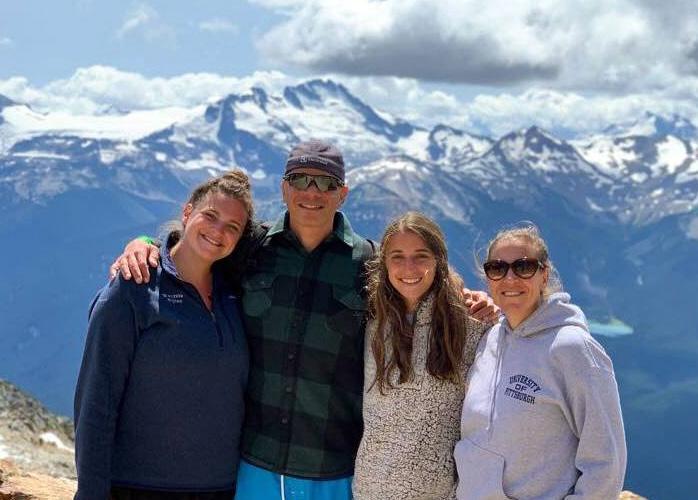
Dania: As the daughter of a Rabbi, Cha bad reminds me of my upbringing in Crown Heights, Brooklyn. It makes me feel connec ted to my roots and family.
Comfort food:
Stu: Chinese food.
Dania: Pizza.
Define Happiness:
By Benjamin WeissStu and Dania Schulman were brought up on the East Coast. They started out as a cou ple in Philadelphia and have been married for 23 years. His work moved the family to Phoenix in 2014, and then to Minneapolis. They are blessed with two daughters: Julia (21) is a senior at the University of Kansas and Lauren (18) is a freshman at the Uni versity of Arizona.
How long have you been in town and what brought you here?
We officially moved to Tucson just a few short weeks ago. We recently became “emp ty nesters” and decided to move back to the desert.
Where did you move from, and how is Tucson compared to it?
We moved from a suburb of Minneapo lis. Spring through Fall is incredibly beau tiful there, and we spent a ton of time in Minnesota’s wilderness and on its many
lakes and bike trails. While Tucson won’t deliver the “lake life” we have come to love, we can’t wait for the warmer winters and desert landscape. We certainly prefer the desert heat in the Summer to the extreme cold of Minnesota in the Winter.
Stu: “Start with Why” by Simon Sinek.
Dania: “Lessons in Chemistry” by Bonnie Garmus.
Stu: I am a “recovering” IronMan triathle te and spend most of my recreational time cycling with friends. I also love to cook.
Dania: I love to spend time boating during the Summer. I also love to garden and cook.
Stu: Rosh Hashanah. I love new begin nings and taking time to reflect on how we’ve treated others. The foods that come
along with the holiday - apple cake, cha llah with honey and even matzo balls - are among my favorites.
Dania: Learning the weekly Torah rea ding with my mother on Sundays.
A cherished Jewish memory:
Shabbat dinners. For us, life is about people and connection. Genuine time with great friends and family is what we love. Our most recent challah was made at the Mega Challah Bake of Tucson, which we at tended for the first time.
Jewish app on phone:
Dania: PocketTorah.
Go-to Yiddish or Hebrew word:
Stu: Kibbitz (Yiddish for hanging around and giving unwanted commentary).
Dania: Peirush Rashi (Hebrew for the scholarly commentary of Rashi, used to des cribe lengthy texts or remarks).
For us, happiness is when we contribute to “better.” We understand that our actions affect others in the world; not just us or our family. We aim to contribute to this world in a positive, meaningful - “better” - way. We don’t aim for perfection. Perfect is unattai nable. We aim to do “better” each day.
Stu: Aches and pains from Ironman trai ning injuries over the years.
Dania: Lack of sleep due to Reggie, our 60-pound boxer/English bulldog mix who in sists on cuddling - and snoring - every night.
Kvell:
Our children! We are proud of them and love them not because of their accomplish ments but because they are wonderful, kind human beings.
Meeting new people! We are determined to develop our own network here in our new home city of Tucson!
LOCAL Photo: Rachel J Walker Photographyfigure: representing Gincredibly model whatever I contri welcomed spend I love education, never Cha Crown connec contribute actions or our world in way. We unattai trai Reggie, our who in night. them and accomplish kind forward to: determined our new
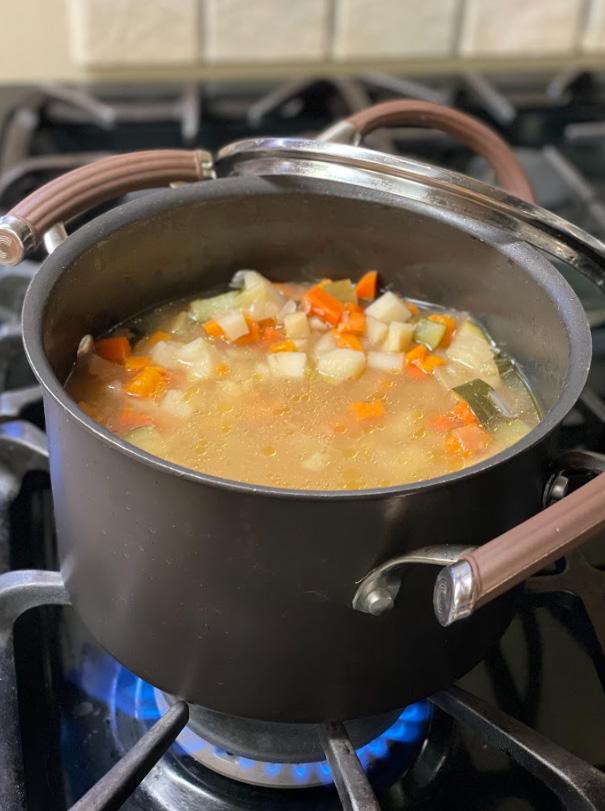 By Feigie Ceitlin
By Feigie Ceitlin

2 onions
6 carrots
4 stalks of celery
½ lb sliced mushrooms
4 potatoes
1-2 parsnip
3 zucchini
2 large sweet potato
2 tbsp flour
Salt Pepper

Dice the vegetables to a similar size.
Saute onions in oil until soft.
Push onions aside and add in 2 tbsp of flour to create a smooth rue.
Add in the rest of the vegetables and mix together.
Add water until 2 inches above the vege tables.
Add salt and pepper
Cover and cook on medium-low flame for about 45 minutes (or until vegetables are soft).
Bon appetit!
— Feigie Ceitlin is the program director of Cha bad Tucson.
The Jewish Holiday of Sukkot begins at nightfall before the 15th of the Jewish (lu nar) month of Tishrei when the moon is at its zenith (October 10, 2022). It continues for another seven days before leading di rectly into the holiday of Shemini Atzeret/ Simchat Torah.
Sukkot is Hebrew for “booths” or “shel ters.” As the verse states, “Your [ensuing] generations should know that I had the chil dren of Israel live in shelters when I took them out of the land of Egypt.”
What were these shelters? The Talmud tells us that they were the clouds of glory that encompassed the entire nation during their epic 40-year trek through the Sinai desert.
3. Sukkot has three other names
Sukkot also has an agricultural conno tation, marking the time when farmers in Israel would gather the crops that had been
drying in the fields. For this reason, scrip ture calls it Chag Haasif, “The Festival of Gathering.”
Sukkot is a joyous holiday—so joyous that the sages called it simply Chag, Hebrew for “Festival.” In our liturgy, we call it Zeman Simchatenu, “The Time of Our Rejoicing.”
The Torah mandates the Israelites to pilgrimage to the Holy Temple three times a year—Passover, Shavuot, and Sukkot— bringing sacrifices and other donations that they may have promised in the preceding months. Sukkot was the last of the three festivals; according to some, it was the final date before the Divine “debts” would be con sidered overdue.
5. The sukkah becomes our second home on Sukkot
For the duration of Sukkot, an outdoor structure called the sukkah becomes our home. We eat all meals, study and schmooze (and some even sleep) in the sukkah.
A sukkah can be erected just about an ywhere, provided that it’s under the sky. The Talmud talks about ox-cart sukkahs, boat sukkahs, treetop sukkahs and came lback sukkahs. Nowadays, Chabad builds sukkah mobiles on pickup trucks and even pedi-sukkahs.
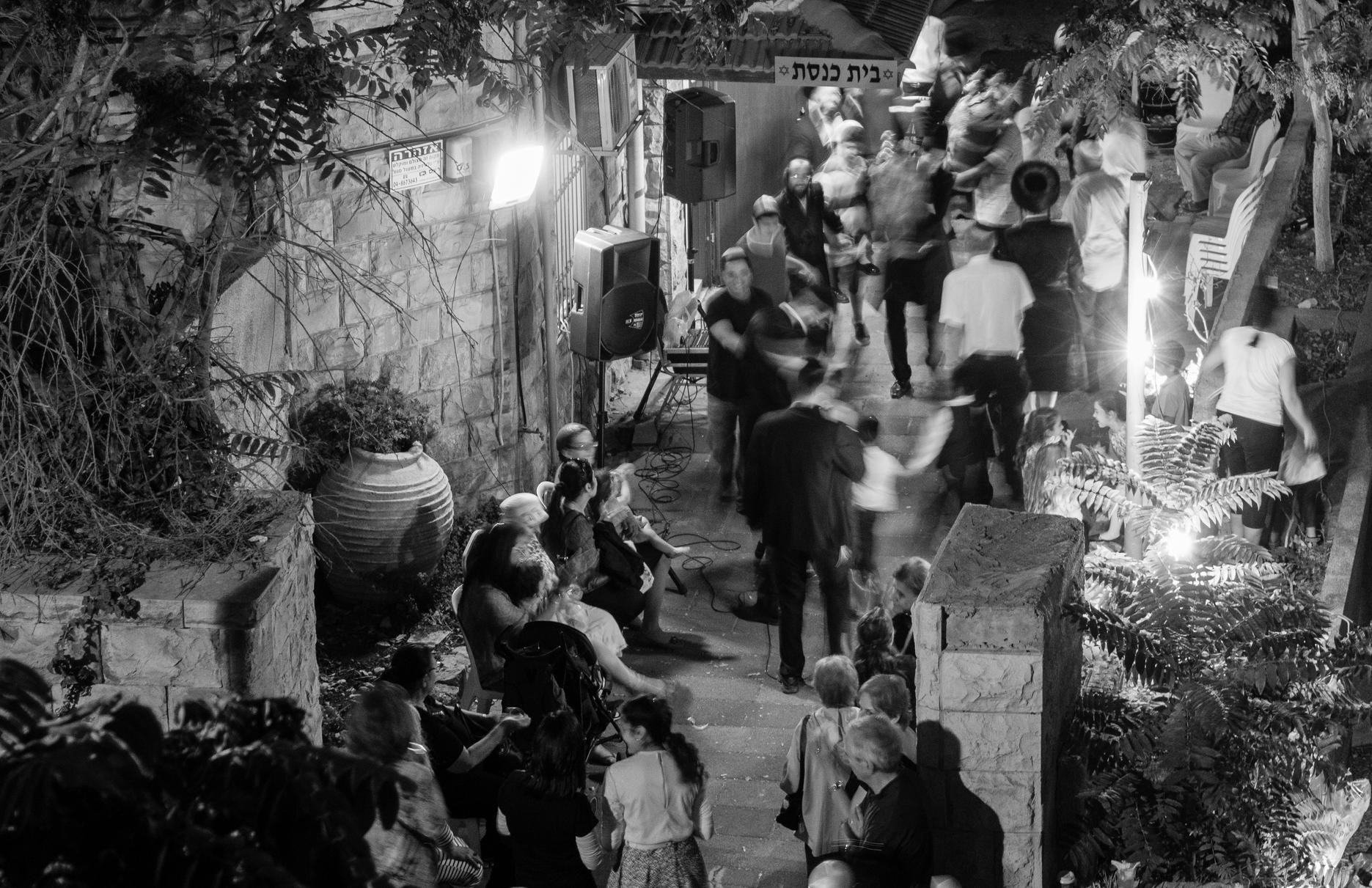
6. The Sukkah is covered with orga nic material
The covering is known as s’chach, which must have grown from the ground and har vested. It cannot be the overhang of a near by tree, for example. Common s’chach choi ces include evergreen branches, cornstalks, palm fronds, bamboo or specially produced mats.
Before eating a meal containing bread or mezonot (cookies, crackers, or cake), the fo llowing blessing is said:
Bah-rookh ah-tah ah-doh-noi eh-loh-haynoo meh-lekh hah-oh-lahm ah-sher ki-dehshah-noo beh-mitz-voh-tahv veh-tzee-vahnoo lay-shayv bah-soo-kah.
Blessed are You, L rd our G d, King of the universe, who has sanctified us with His commandments and commanded us to dwell in the sukkah.
When eating in the sukkah for the first time this year, say the following blessing:
Bah-rookh ah-tah ah-doh-noi eh-loh-haynoo meh-lekh hah-oh-lahm sheh-heh-khehyah-noo veh-kee-mah-noo ve-hig-ee-yah-noo liz-mahn hah-zeh.
Blessed are You, L rd our G d, King of the Universe, who has granted us life, sustained us and enabled us to reach this occasion.
According to a mystical tradition in the Zohar, “seven shepherds” visit our sukkahs each day of the holiday. Known as ushpizin, the honorable guests are Abraham, Isaac, Jacob, Moses, Aaron, Joseph and David.
Every day of Sukkot (besides for Shabbat), we take a bundle of greens—made of a lulav (palm frond), three hadasim (myrtles), and two aravot (willows)—along with an etrog (citron). They are referred to as the “lulav and etrog” or the arba minim, “four kinds.” (Do you need a set? Contact Chabad).
The following blessing is said while hol ding the lulav bundle in your right hand:
Bah-rookh ah-tah ah-doh-noi eh-loh-haynoo meh-lekh hah-oh-lahm ah-sher ki-dehshah-noo beh-mitz-voh-tahv veh-tzee-vahnoo ahl neh-tee-laht loo-lahv.
Blessed are You, L rd our G d, King of the universe, who has sanctified us with His commandments, and commanded us regar ding taking the lulav.
We then shake them in all directions. We use them during Hallel as part of the holi day morning service and during Hoshaanot, a daily Sukkot ceremony that involves cir cling a Torah scroll while chanting prayers for salvation.
On the seventh day of Sukkot, the bi mah is circled seven times with the lulav
Simchat Torah celebration outside a synagogue in Haifa, Israel * Photo: RnDmSSunday, Oct. 9
Eve of Sukkot
Candle lighting 5:40 PM
Monday, Oct. 10
First Day Sukkot
Light candles after 6:34 PM
Tuesday, Oct. 11
Second Day Sukkot
Yom Tov ends at 6:32 PM
Sunday, Oct. 16
Hoshana Rabba
Candle lighting 5:32 PM
Monday, Oct. 17
Shmini Atzeret
Candle lighting after 6:26 PM
Tuesday, Oct. 18
Simchat Torah
and esrog. Since the Hoshaanot verses are said repeatedly, this day is known as Hos hana Rabbah (“The Great Hoshana”). At the end of this once-a-year service, each person beats a bundle of five willows against the ground.
On this day, it is customary to have a fes tive meal in the sukkah that includes cha llah dipped in honey (the last time for the season) and kreplach (dumplings stuffed with meat).
During Temple times, the nights of Sukkot were celebrated with extreme joy, to the degree that the sages testified, “An yone who has not seen the joy of the water drawing, has never seen joy in his life.” The celebrations preceded the drawing of water from the Shiloach spring and poured on the
Temple altar.
Priests kindled fires on great lamps, lighting up Jerusalem as if it were the middle of the day. Scholars juggled and held torches throughout the night, and Levites played music, while the laypeople watched with excitement.
Nowadays, many communities hold cele brations on the nights of Sukkot in comme moration of the water-drawing ceremony. The Rebbe encouraged dancing to be held in the streets.
The first two days of Sukkot (just the first day in Israel) are Yom Tov. Like Shabbat, we refrain from many forms of creative la bor, travel, etc. The only two exceptions are that some acts of food preparation (such as cooking using a pre-existing flame) and ca rrying things we need for the holiday are allowed. The prayers are also somewhat longer than usual.
The remaining days of Sukkot are known as chol hamoed, during which travel and other melachot (forbidden acts) are permit ted (but strenuous work should be avoided if possible). Families typically go on outings, enjoying each other’s company.
13. Sukkot is followed by another jo yous holiday
Immediately after the seven days of Sukkot, we step into the happy holiday of Shemini Atzeret/Simchat Torah (Octo ber 16-18, 2022). It is the only instance of one Jewish holiday coming directly after another one.
In Israel, it is confined to a single day. In the Diaspora, this holiday extends for two days. Both days are celebrated by nightly candle lighting, festive meals both night and day, and desisting from work.
On the first day, still dwell in the sukkah, but without a blessing. Yizkor, the memorial for the departed, is also said on this day.
The second day, during which we comple te and immediately begin the annual Torah reading cycle. This joyous milestone is mar ked with vigorous singing and dancing, tra ditionally following seven circuits known as hakafot, as the Torah scrolls are held aloft.
Keeping Jewish | October 2022 | 11 Yom Tov ends at 6:24 PM

On September 18, 2008, I was sitting on the lawn of the National Constitution Cen ter in Philadelphia, watching a rare scene. Mikhail Gorbachev was awarded the Liber ty Medal - an award the United States gives to individuals who have fought and sacrifi ced to bring liberty where it has previously been denied. The former Soviet leader and Noble Prize winner was being celebrated as a force responsible for ending the Cold War.
Gorbachev was praised for the hope he gave to the millions hidden behind the Iron Curtain. Hundreds of people around me watched U.S. President George W. Bush put the medal on Gorbachev’s chest while I sat there in absolute awe, recognizing how com pletely impossible this moment had seemed just a short while before.
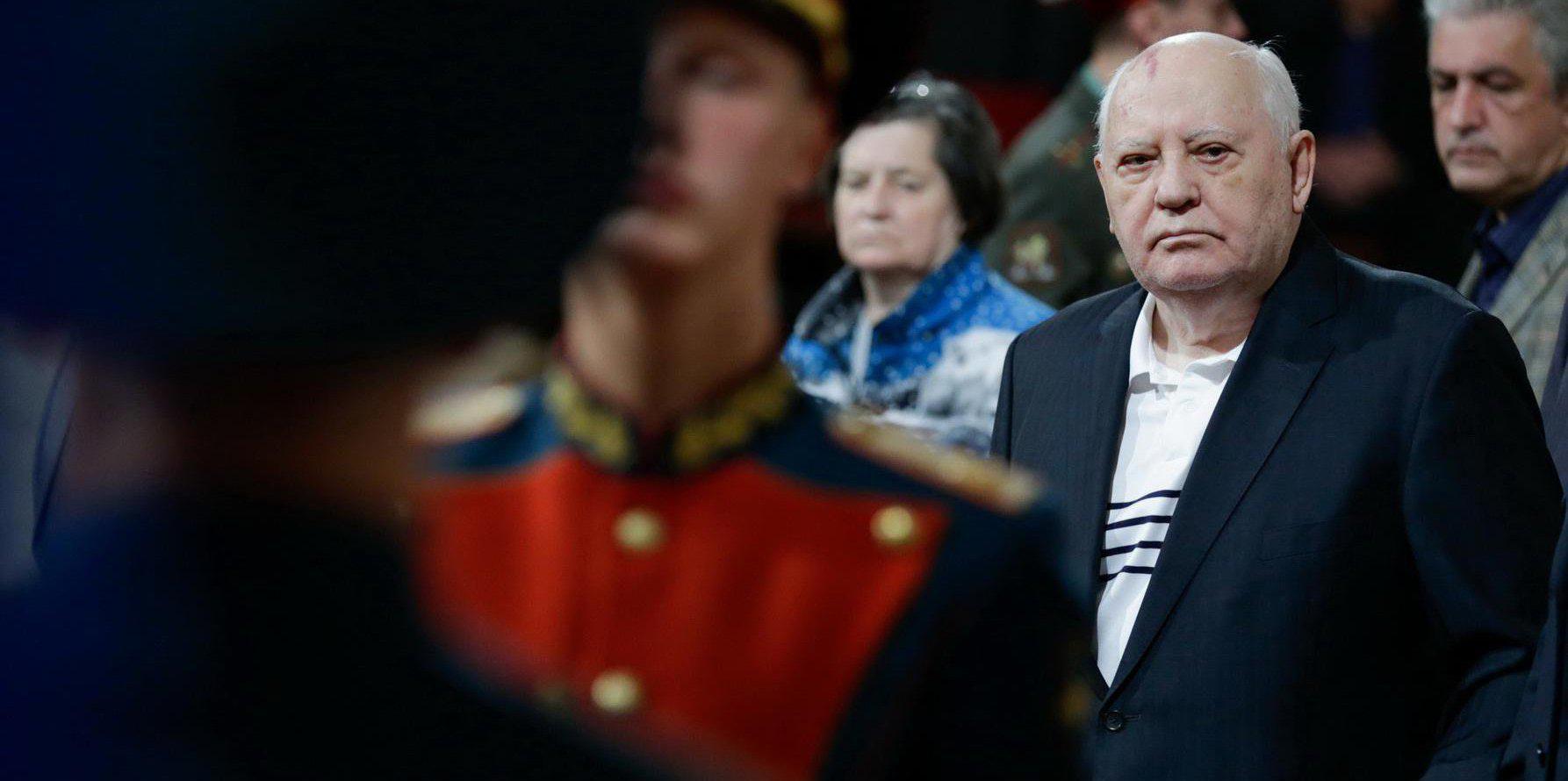
That surreal moment with Gorbachov — with presidents of nations that were once bitter enemies - now laughing and shaking hands taught me to try and think outside of my self-imposed limitations and trust in our Creator’s abilities.
By Sofya Sara Esther TamarkinIt takes courage to fearlessly believe in the possibilities of tomorrow because it can appear irrational and even insane. All of our past experiences can point to a very specific and horrible outcome. But when we are pushed by circumstances to the brink of despair, it is important to remind ourselves of the possibility that tomorrow will be mag nificent.
I was born in the former Soviet Union during the reign of the Communist regime. Growing up, it was impossible to imagine that one day I would live to write this ar ticle. It was completely unrealistic and un feasible. A crazy thought. But it was indeed not only possible - it was what came to pass - against all odds.
I was raised on a steady diet of frighte ning facts about America. I would probably have been too scared to even fly above the United States on an airplane in my early years. I failed English in second grade, and my teacher confidently declared to my pa rents that I would never master the langua
ge. This, she affirmed, was unachievable for me.
And, of course, there was the Jewish factor; anti-Semitism influenced my life. My identity felt more like a genetic disease than a “light upon the nations.”
Every probability would have predicted my life to be the opposite of what it is to day. My real-life story and that of millions of other Russian-born Jews prove that past re sults are not guarantees of future outcomes.
When Gorbachev was done speaking, I moved with the crowd to see the two heads of state exit the stage. I suddenly felt ex hausted and light-headed. I asked the se curity guard if I could use the washroom. I was pointed to the Constitution Center Building.
I moved slowly, processing this memora ble moment, and suddenly, I saw Gorbachev walking with his security guards towards me on their way to the celebratory dinner. I
stared in disbelief. As he walked passed me, I surprised myself by speaking in Russian without thinking of what I was about to say.
“Mr. Gorbachev,” I said, “I am a Russianborn Jew. We immigrated in 1989. I respect you and feel gratitude for the life I have to day. Meeting you is a great honor. May I ask you for your autograph as a memory of this important day?”
Without a blink of an eye, he simply re plied with a phrase that summarized this entire experience for me: “Your life is my au tograph.” He continued to move forward as I stood frozen, watching him, thinking about his profound words.
It took me a while to compose myself and return to my family outside, yet the lesson that Mikhail Gorbachev taught me conti nues to be as meaningful today as ever.
I am a link in the eternal chain of collec tive Jewish destiny. Again and again, the Jewish nation miraculously survived uns
peakable If my of a Soviet considered the Jewish hout history. bound tendencies toy famously cred being ven the with it
The upon that happen
Mikhail Gorbachev in June 2015 * Photo: duma.gov.ru Gorbachevpeakable calamities, tragedies, and pain. If my life can be viewed as an autograph of a Soviet leader, then it certainly can be considered a sign of all the miracles that the Jewish people have experienced throug hout history. We are an eternal nation—not bound by presumed limitations, natural tendencies and mediocrity. Even Leo Tols toy famously declared: “The Jew is that sa cred being who has brought down from hea ven the everlasting fire and has illuminated with it the entire world.”
The Torah teaches us that we are a “light upon the nations,” and we must remember that anything—absolutely anything—can happen with G-d at the helm.
“Think good, and it will be good” is a Chassidic motto. The outcomes of our expe riences do not appear out of nowhere. With our belief in G d, we shape our reality.
Jewish people today are the autographs of the sacred covenant with the Almighty G d Himself. We have not only survived but flourished again and again. Open your life to the miraculous outcomes. Anything can happen, for you have the power to autogra ph your life with the mark of an infinite Creator with endless possibilities.
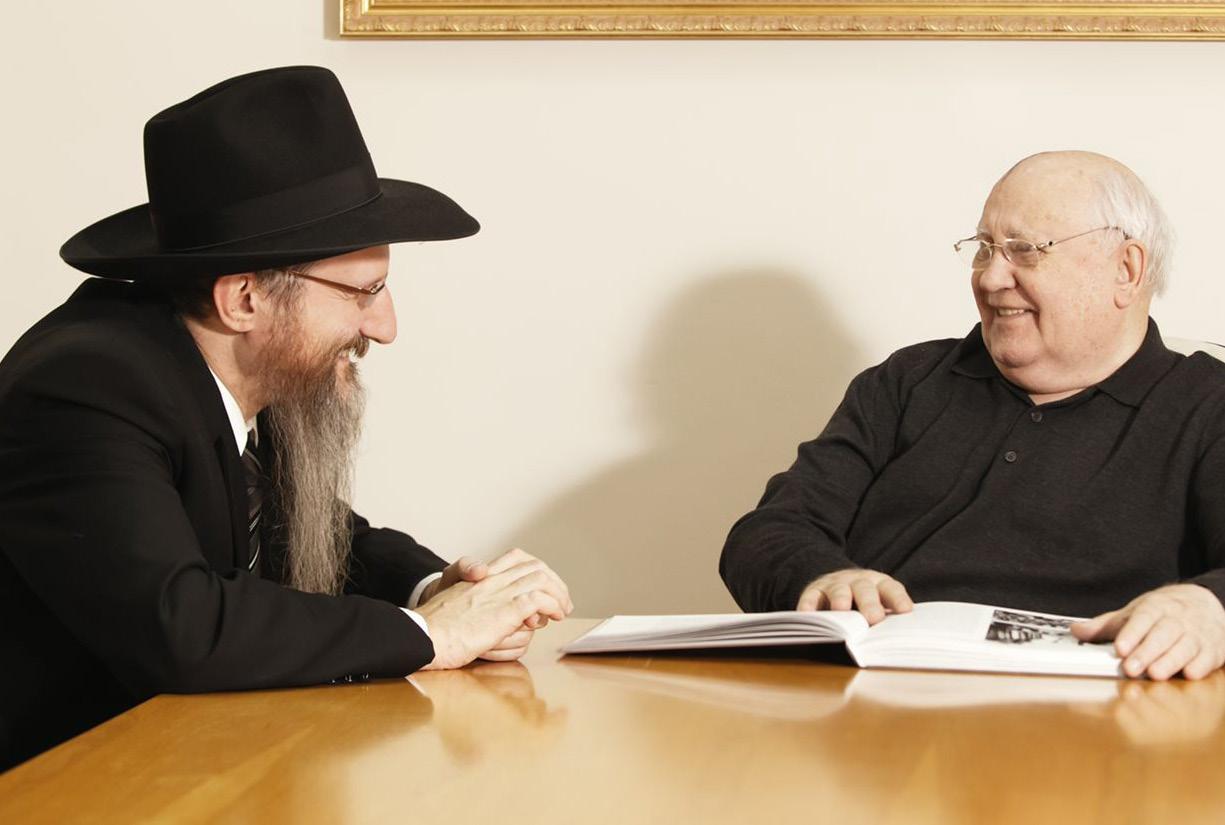
- Born in the Soviet Union, Sofya Sara Esther Tamarkin lives in Philadelphia, runs an ortho pedic company and is involved with the Russian American Jewish Experience (RAJE)
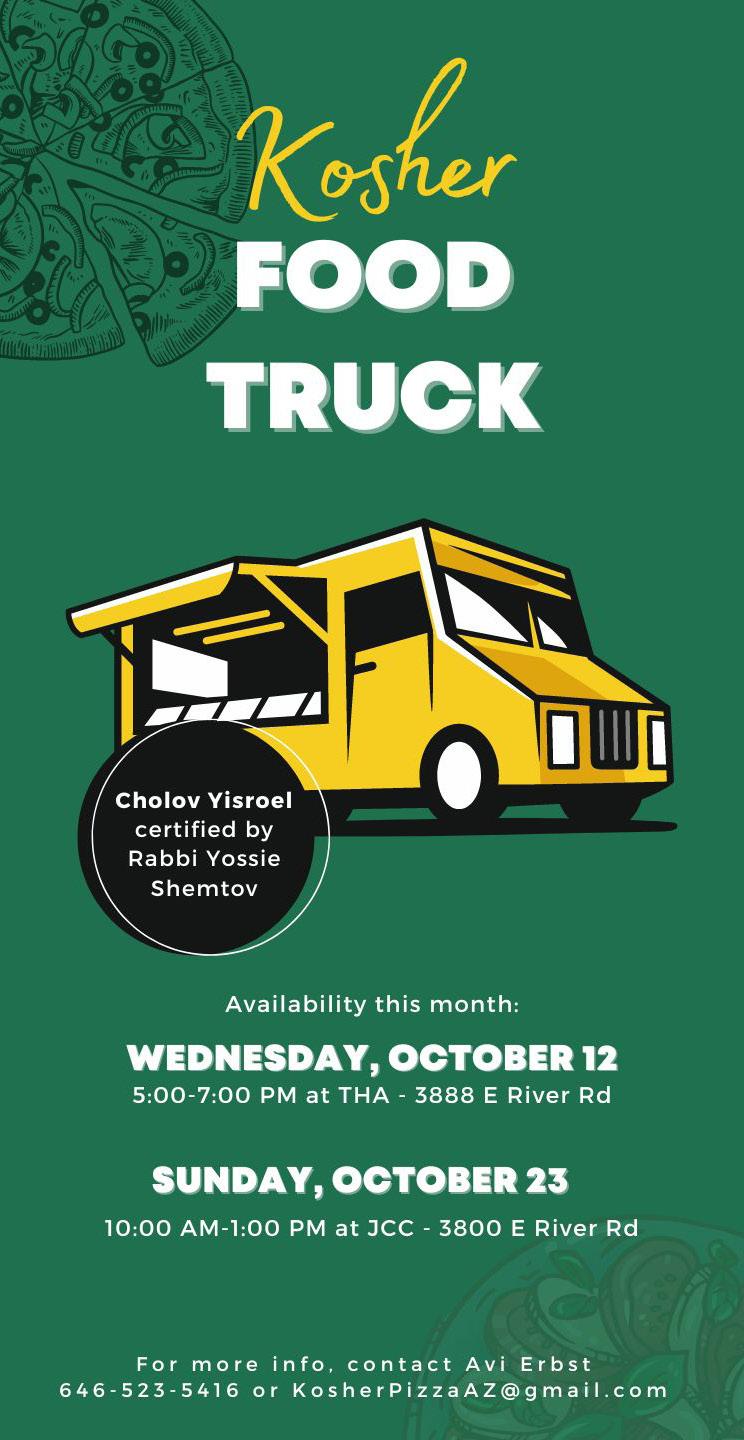

 Mikhail Gorbachev meets with Russia’s Chief Rabbi Berel Lazar, October 2012
Mikhail Gorbachev meets with Russia’s Chief Rabbi Berel Lazar, October 2012
Sukkot is tricky. We have men building houses, keeping plants alive, and dancing in public. None of those are things Jewish men know how to do – so I am here to answer questions that have come up (or are likely to) for this complex holiday.
Question: Should we get a carpet for our sukkah?
Sure. The salesperson at the carpet sto re won’t try to talk you out of it. I mean, they are there to sell carpets. And there is nothing as awesome as a sukkah that has a carpet in it, because that way it’s just like your home - except that your home doesn’t have carpet in your dining room, becau se your kids eat like Cookie Monster, with more food ending up on the floor than in their mouths. Which you can’t clean. This is why you have no carpet in your dining room... which makes me rethink my origi nal answer.
*
weather alert notifications. Normally, if it rains at night, things are dry by the mor ning, thanks to the sun. But the sukkah just happens to be designed to block out most of the sun. Also, the thing about Sukkot is that even long after it stops raining, it’s still raining in your sukkah. And according to Jewish law, if it isn’t raining OUTSIDE, you should be staying in the sukkah. Think of it as creating environmental awareness…
* Question: How do I hang decorations so they won’t fall?
Many people use tape, although many pick up their decorations from the ground and retape them every hour because the tape won’t stick, especially when the sukkah is damp. (See the previous question about rain).
But a sukkah is supposed to be like your home, right? How do you hang pictures at home? Hammer and nails! Though this will be difficult if you have a canvas sukkah. Also, the kids can knock down anything, even if you use a hammer and nails.
By Mordechai SchmutterQuestion: My kid made a picture of a sukkah to hang in my actual sukkah. Why do I need this? I’m in a sukkah! I don’t have a picture of a house in my house!
Well, first, you have to understand where this is coming from. Jewish law says that we’re supposed to hang nice things in the sukkah as we would in our house. Persona lly, in my house, I’ve put up a set of three flyswatters, a certificate that says that I completed Mitzvah Clown Training, and a puzzle showing a picture of a half dozen cows drinking from a fountain - all crooked. So I don’t see how hanging those things “like in our house” is actually respectful to the sukkah.
I say we should be creative about what we hang in the sukkah. Like maybe hang a “Mizrach” sign, so everyone you have over knows where east is when they pray. Or ma ybe hang 140 pictures of each of your kids. You come home from the portrait studio with 144 pictures of your kids, you’ve given
one to each set of grandparents, you have one in your wallet, and your kids probably don’t have 141 other grandparents. So the rest are sitting around and getting outda ted. They could really dress up the sukkah.
And all those pics of your kids will dis tract anyone who might think about stea ling your vital “Mizrach” sign.
“Let’s take that! We’ll always know where east is!”
“That’s so cool! How does it know?”
* Question: Why does it always rain on Sukkot?
It’s not only Sukkot. It also always rains Passover, usually while you’re burning the chametz. You can almost never guarantee that you can stand outside for 8 days and not have it rain. You just usually don’t know about it, unless you have those annoying
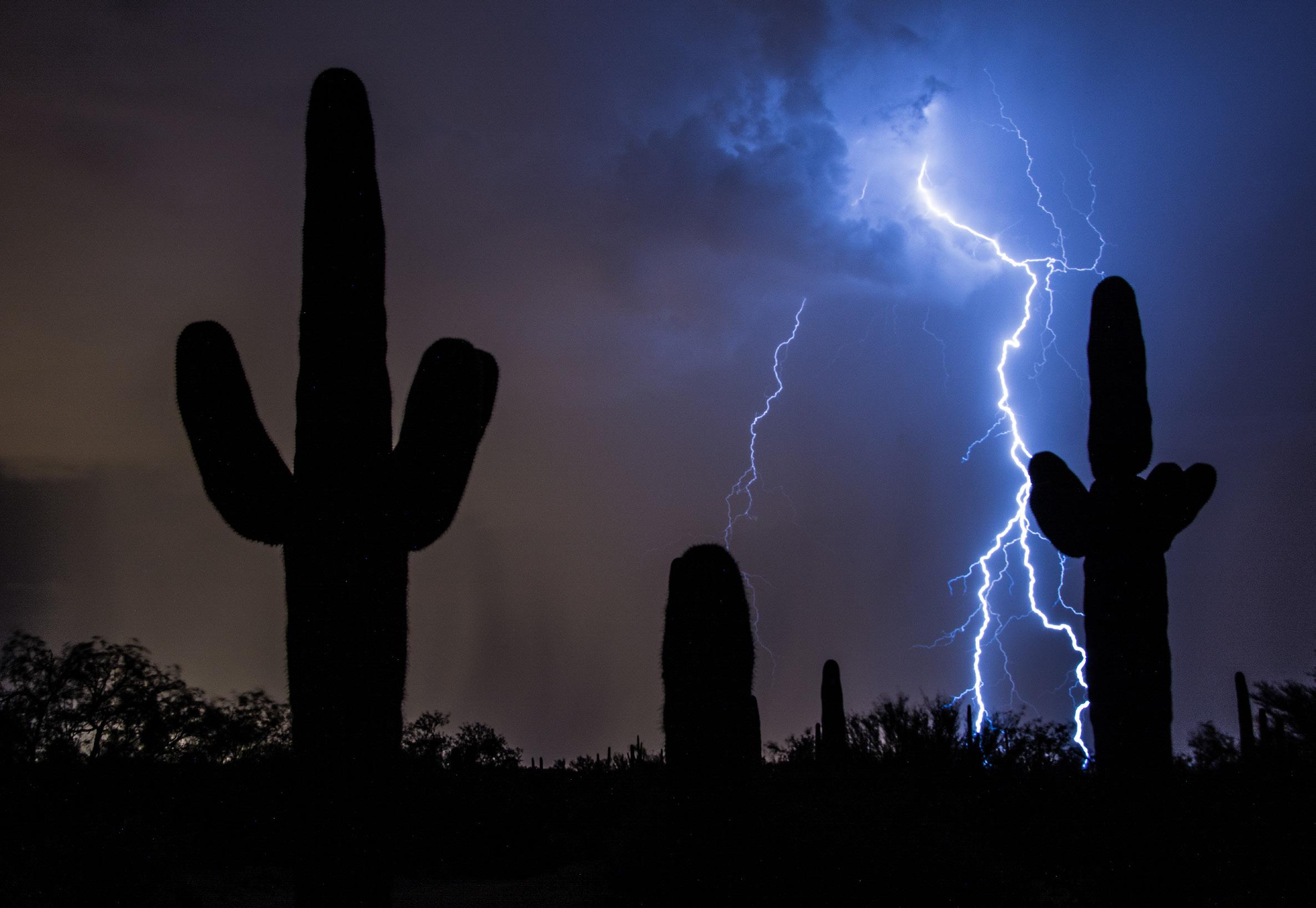
Your best hope is to hope that after the pictures fall, they land face up, so you can still enjoy them on Yom Tov as you step over them. The problem is that, logically, a pictu re toppling off a wall will probably not land face up. So my advice is to hang your pictu res facing the wall.
* Question: Should I get a rain hat for my sukkah?
Yes. Your sukkah will look adorable in a rain hat, and be far more comfortable than a wet sukkah, especially if you have a carpet. Otherwise, you will spend the entire time walking around the sukkah going squish, squish, squish. You could also get a schlock thing, which is Yiddish for “something che ap and inferior,” and lay it over your sukkah and pray that the rain starts weighing it down before the wind blows it away.
Assuming it doesn’t blow off, the schlock could keep your sukkah dry. In fact, maybe you should get a carpet for your sukkah and put it over the top. Those are absorbent!
HUMOR Lightning and clouds behind the silhouette of Saguaro cactus, taken during a monsoon storm in Tucson, Arizona in 2016 * Photo: Digital Intuitive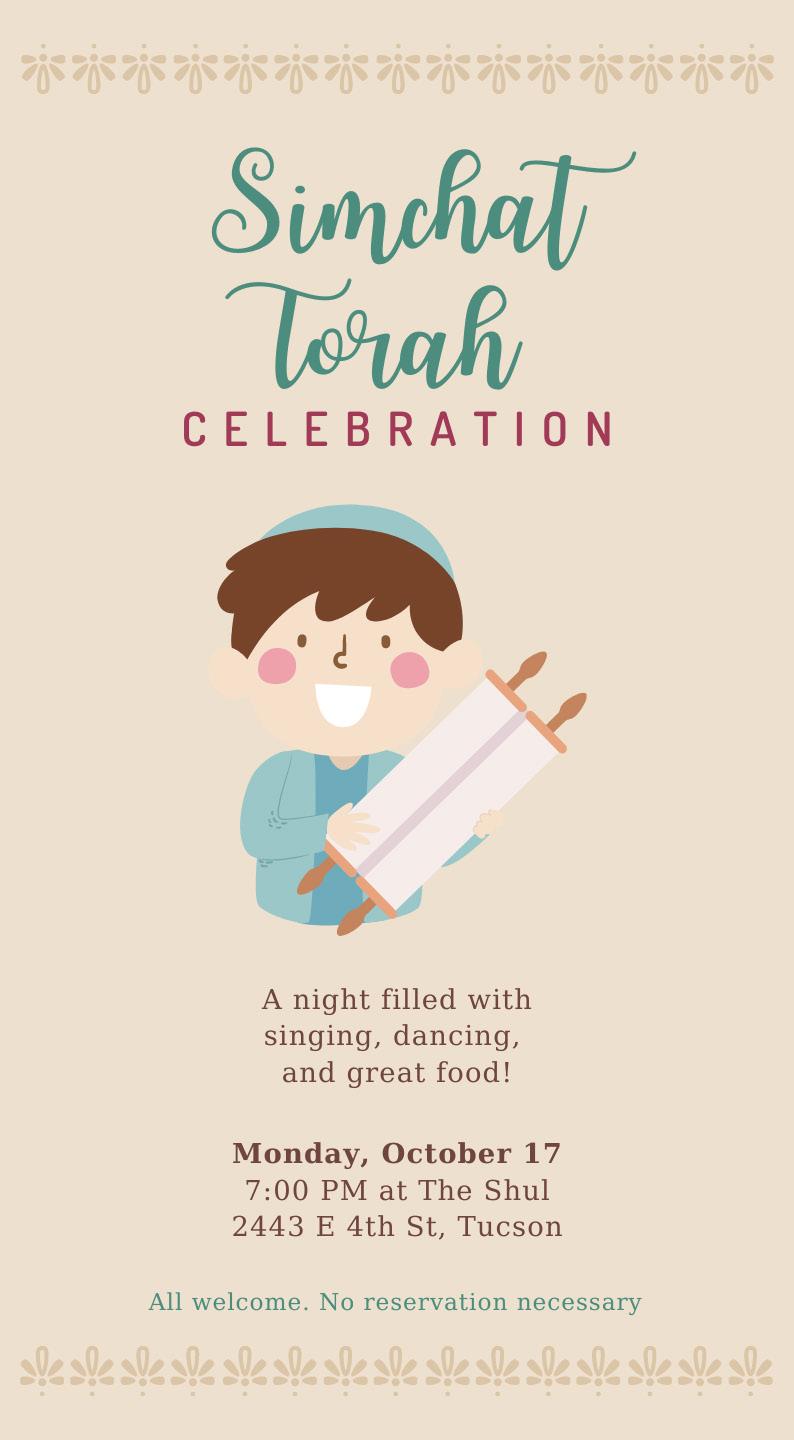
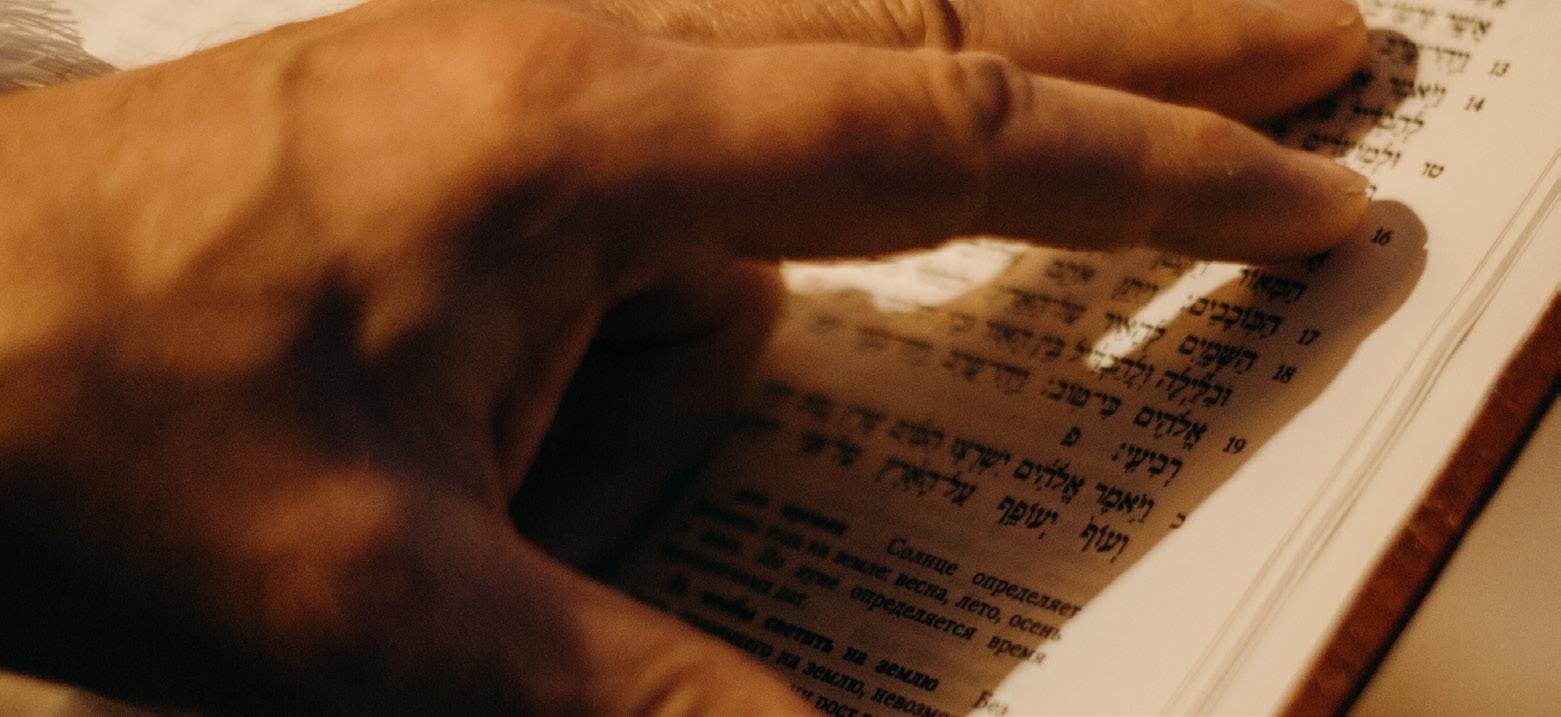
1. What did G-d make on the first day of creation?
A. Light and dark
B. Water and dry land
C. The stars and the sun
2. What did G-d do on the seventh day— Shabbat?
A. He created wine and bread for the hea venly Shabbat meal
B. He rested and blessed the seventh day
C. He transcribed the Torah portion of the week in the Heavenly Scroll
3. Which of the following is NOT one of the four rivers that flowed from Eden?
A. Pishon
B. Yarden
C. Chidekel
D. Perat
4. Which fruit did G-d tell Adam not to eat?
A. The fruit of the Tree of Life
B. The fruit of the Tree of Knowledge
C. The fruit served by the cunning serpent
5. Why was the first woman named Eve (Chava)?
A. Because she was created toward the end of the sixth day of creation
B. Because she was in “a state of constant joy” (hava nagila)
C. Because she was “the mother of all life” (chai)
6. What were the occupations of Cain and Abel?
A. They were both hunter-gatherers
B. Abel studied Torah, but Cain was drawn
C. Cain was a farmer and Abel was a she pherd
7. Who coined the phrase: “Am I my brother’s keeper?”
A. Adam, who expressed his gratitude to G-d for making him an only child
B. Abel, who was ashamed of how Cain had acted out of jealousy
C. Cain, who murdered his brother and was not keen to admit it
8. What was the name of the third son born to Adam and Eve?
A. Seth (“for G-d has given me other seed”)
B. Lemech (“for what is the purpose of life on Earth?”)
C. There was no third son, only Cain and Abel
9. Which of Adam’s descendants lived even longer than he did?
A. Jared and Methuselah, who lived 962 and 969 respectively
B. Methuselah, the only human to outlive Adam, died at 973
C. Jared and Lemech both lived 983 years, the ultimate full life
10. Rashi Bonus: What would one have ex pected the Torah to start with?
A. The Exodus narrative, the birth of the Jewish people
B. The first mitzvah, sanctifying the new moon
C. The birth of Moses, redeemer of Israel
Answers:1-A,2-B,3-B,4-B,5-C,6-C,7-C,8-A,9-A,10-B.
FUN PAGE Photo: cottonbro / Pexels